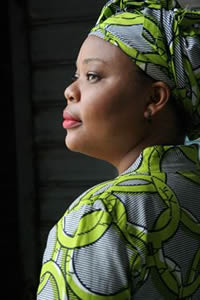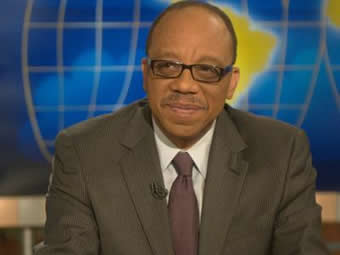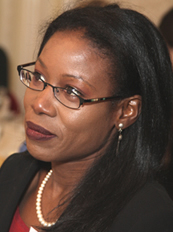The Best of the Rest
Ten Favorite Books From 2011
For Sunday January 1, 2012
New Year's Day
Lectionary Readings (Revised Common Lectionary, Year B)
Isaiah 61:10–62:3
Psalm 148
Galatians 4:4–7
Luke 2:22–40
One of the great things about reviewing a book a week for Journey with Jesus is that I can read whatever I want. Consequently, my reading habits have become highly eclectic — five miles wide and six inches deep, as they say. Our Comprehensive Index of Book Reviews, for example, organizes our reviews under fourteen different subject categories like history, politics, science, art, and memoir.
Careful observers might notice one peculiarity about my reading tastes — only a dozen fiction titles in over four hundred reviews in eight years (including two each by Anne Rice and Marilynne Robinson). Don't ask me why; I don't know. I resolved to read more fiction last year, and made a modest effort, but otherwise I remain stuck in my non-fiction ways.
 |
Leymah Gbowee. |
Unless someone loans me a title, I get all my books from the public library. Every once in a while I'll buy a book, like the spectacular collection of cosmic photos called Far Out (2009) by Michael Benson. I'm not a gadget guy, and my writing requires me to stare at the computer screen way too long already, so I never use an e-reader. Nor do I want one. I read one book at a time, and if I start a book my obsessive compulsive nature makes me finish it.
Over the holidays I've looked back over the fifty-two books JwJ reviewed this year. There's no accounting for personal taste, of course. I was so captivated by House of Prayer No. 2 by Mark Richard that I devoured it in a day, but after my wife finished it she just shrugged her shoulders. Anyhow, here are ten favorite titles from 2011. I've listed them alphabetically by author, and in no particular order. For my full review, click on the book title.
G.W. Clarke, translation and introduction, The Octavius of Minucius Felix, no. 39, Ancient Christian Writers (New York: Newman Press, 1974), 414pp.
How did elite Romans view the early Christians? And how did Christians respond? Minucius Felix of the early third century gives us one snapshot of this exchange in his dialogue between two friends. Caecilius presents his pagan criticisms. He derides Christians as "utter boors and yokels, ungraced by any manners or culture." In style and content their Scriptures were crude. They adhered to absurd doctrines like the resurrection of the body and providence. Rumors about their cannibalism, incest, and infanticide were well known. They were antisocial, avoiding the theater and the games, and apolitical, refusing to run for office. The Christians, said Caecilius, "do not understand their civic duty." The treatise provokes a complex and controversial question: to what extent were upper crust Romans turning to the faith by the late second century?
Leymah Gbowee, with Carol Mithers, Mighty Be Our Powers, A Memoir: How Sisterhood, Prayer, and Sex Changed a Nation at War (New York: Beast Books, 2011), 246pp.
Gbowee's memoir hit the bookstores in September of 2011, one month before she won the Nobel Peace Prize with two other women. One night she had a dream in which God spoke to her, "Gather the women to pray for peace." That dream became Liberia's Christian Women's Peace Initiative, in which Christian and Muslim women joined forces. They gathered in the mosques and markets, shared their personal horror stories, held weekly prayer meetings, denied men sex until peace came, forced Charles Taylor to peace talks in Ghana, and then in Ghana they barricaded the do-nothing men in their plenary hall until they signed peace accords. After the 2003 accords, they were instrumental in disarming the country, registering voters, and electing Ellen Johnson Sirleaf as Africa's first woman head of state.
Peter Godwin, The Fear; Robert Mugabe and the Martyrdom of Zimbabwe (New York: Little, Brown and Company, 2010), 371 pp.
Peter Godwin has reported from sixty countries as a foreign correspondent, but in this book he returns to his childhood home of Zimbabwe. In 1980 the nation won its independence and Robert Mugabe (b. 1924) was elected president. He's still president, and the world's oldest leader. Zimbabwe once enjoyed one of the highest standards of living in Africa, but under Mugabe's reign of terror the country has redefined state dysfunction. Unemployment is 94%. Life expectancy has plummeted from sixty to thirty-six. One third of the population has fled the country. The country has a one trillion dollar note. Godwin's book is a startling expose of Mugabe's torture state, especially as that was unleashed during the presidential and parliamentary elections of 2008. He writes: "I am bearing witness to what is happening here — to the sustained cruelty of it all. I have a responsibility to try to amplify this suffering, this sacrifice, so that it will not have happened in vain."
Philip Jenkins, The Lost History of Christianity; The Thousand-Year Golden Age of the Church in the Middle East, Africa, and Asia — and How It Died (New York: HarperOne, 2008), 315pp.
Protestant, Catholic, and Orthodox churches dismiss the Nestorians and Monophysites as heretics. Consequently, their histories were "lost" to the rest of Christendom. This is startling, for both groups affirmed the decrees of Nicea. "We must never think of these churches as fringe sects rather than the Christian mainstream," writes Jenkins. And when the Nestorian patriarch Timothy became the leader of these churches around the year 780, he wielded more influence over more Christians than the pope in Rome and perhaps the patriarch in Constantinople. The gospel spread west to Rome and east to Constantinople, but it spread faster and even further east, thanks to the Monophysites and Nestorians, to what are now Armenia, Turkmenistan, Uzbekistan, Syria, Egypt, Iraq, Iran, Yemen, India, Tibet and China. Jenkins' book is a work of historical retrieval and reconstruction. But he also considers the near extinction of Christianity in these lands. Between 1200 and 1400 almost all of these churches were vanquished by Islam except for remnants like Coptic Christians in Egypt — a stunning reversal of fortunes for a once powerful presence.
 |
Eugene Robinson. |
Diarmaid MacCulloch, Christianity, The First Three Thousand Years(New York: Viking, 2010), 1161pp.
MacCulloch tells the Christian story in all its staggering diversity, with attention paid not only to the Latin West (Catholic and Protestant) and Orthodox East, but also to the believers whose stories have been marginalized or forgotten — Syriac, non-Chalcedonian churches, both Miaphysite and Diophysite. The mission impulse of the earliest believers (for good and ill) is also a constant theme. Majestic in scope and meticulous in scholarship, MacCulloch has written the new gold standard for a one-volume history of Christianity. The 68 full color plates of art, architecture, sculpture and photographs, and 100 pages of footnotes and bibliography "for further reading," are alone worth the price of the book. Although the book retails for $45, on Amazon you can purchase a new copy for under $25.
Mary Oliver, Swan; Poems and Prose Poems (Boston: Beacon Press, 2010), 63pp.
In 2007 the New York Times described Oliver as "far and away, this country's [America's] best-selling poet." Swan is her twentieth volume of poetry, in addition to eight volumes of prose and two audio books. Her collection American Primitive (1984) won the Pulitzer Prize for poetry, while New and Selected Poems (1992) won the National Book Award. Oliver is famous for her solitary walks near her home in Provincetown, Massachusetts, and how those walks provide a rich fund of material for her poetry: "this gift of the world I adore so much and want to belong to." The forty-five poems in Swan follow this tried and true method. Her empirical observations about nature lead to spiritual intimations about humanity: In the poem from which the book gets its title, "Swan," she concludes: "And did you feel it, in your heart, how it pertained to everything? / And have you too finally figured out what beauty is for? / And have you changed your life?"
Mark Richard, House of Prayer No. 2; A Writer's Journey Home (New York: Doubleday, 2011), 207pp.
House of Prayer No. 2 is Richard's first book of non-fiction. What makes it wonderfully strange is that he's written the memoir in the second person. The effect suggests the distance and detachment that Richard experienced toward his own body as a crippled child and toward people who marginalized him as "special." He not only tells how he became a writer; he also tells how he found redemption in a place "where only God knows how close you came to what could have been, and only His grace saved you from it" (emphasis his). By the end of the story Richard has his own call to ministry as the only white congregant at the black House of Prayer No. 2, and is slain in the Spirit as Mother Ricks places her hand on his shoulder and testifies about the fulfillment of a dream she had long, long ago.
Eugene Robinson, Disintegration: The Splintering of Black America (New York: Doubleday, 2010), 254pp.
There are 40 million African Americans in the United States. For decades they have both enjoyed and endured a single interpretive narrative of a people with a homogeneous culture. This monolithic black America, says Robinson, is gone forever. Black America has experienced a radical "disintegration" that is both hopeful and dispiriting. Robinson proposes that black America has fragmented into four groups that are "increasingly distinct, separated by demography, geography, and psychology. They have different profiles, different mind-sets, different hopes, fears, and dreams." An enormous black middle class has entered America's mainstream. Elite transcendents include people like Oprah and Obama. Emergents are comprised of immigrants from Africa and the Caribbean, and blacks in biracial marriages. Then there are the abandoned who are "profoundly isolated," and who have created their own "cultural ecosystems."
 |
Isabel Wilkerson. |
Jason K. Stearns, Dancing in the Glory of Monsters; The Collapse of the Congo and the Great War of Africa (New York: Public Affairs, 2011), 380pp.
The deadliest war of our generation has been the under-reported conflict in the Democratic Republic of the Congo (former Zaire). Since the start of conflicts there in 1996, five million people have perished out of a population of fifty million — a staggering 10% of the population. How do you understand a war in a country the size of western Europe (the twelfth largest in the world), with 200 ethnic groups, and that involved nine border countries, the interventions of countries like France, Belgium, the United States, Cuba, and China, and thirty rebel militias and proxy armies composed of mercenaries from as far away as Serbia? Stearns has written a critically-acclaimed account, based upon ten years of living and reporting from the region. His book bears witness to the untold stories of many millions of Congolese citizens.
Isabel Wilkerson, The Warmth of Other Suns; The Epic Story of America's Great Migration (New York: Random House, 2010), 622pp.
In America's "Great Migration," between 1915 and 1970 six million blacks migrated from the south to the American north and west. When the migration began, about 90% of blacks lived in the south; sixty years later only 50% of them did. Wilkerson, who won a Pulitzer Prize in 1994 as the Chicago bureau chief for the New York Times, interviewed 1200 migrants for her book. She humanizes their history by telling the stories of three families who represent the three main paths that blacks took out of the south — up the Atlantic seaboard to the northeast, up the spine of the country to the cities of the midwest, and then west, mainly to California. We owe a debt to these brave people who fled what Wilkerson calls a "feudal caste system," and who forced America to confront two hundred years of racism.
Howard Zinn, A People's History of the United States, 1492–Present (New York: HarperCollins, 1980, 2003), 729pp.
Who gets to write history and so shape the narratives by which we live? Most history is written "from above," that is, by and about elites like presidents, generals, and scholars. Zinn (1922–2010) reads and writes history "from below," from the perspective of a coal miner, a black slave, or a Vietnamese rice farmer. Among his more than thirty books, A People's History is Zinn's best known work, having sold more than a million copies. He wrote the book "to awaken a greater consciousness of class conflict, racial injustice, sexual inequality, and national arrogance" (p. 686), especially as those are expressed in the marriage of predatory capitalism, permanent militarism, government power, and unjust laws.
OK, sorry, that makes eleven!
Image credits: (1) The Advocates for Human Rights; (2) TheGrio.com; and (3) Boston University.





